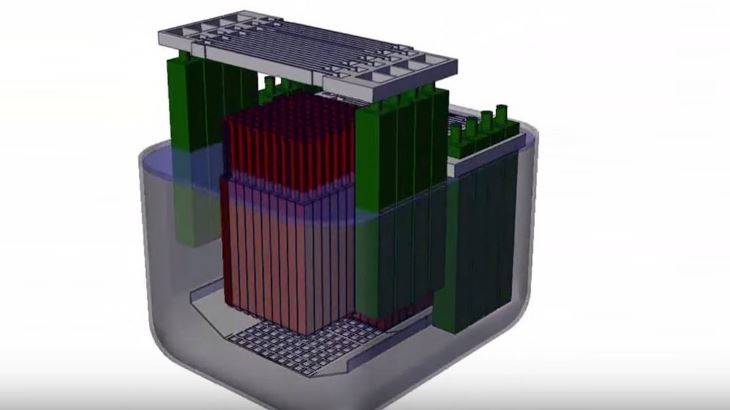
The Dazzling Chimera of “Small Modular Nuclear Reactors” – Only if you don’t look too close.
Its a perennial puzzle for the Canadian public- the blithely repeated but already refuted nuclear industry claims for ‘small modular reactors.’ The catchy industry words and phrases remain unaltered and misleading. And that’s the case with the Chronicle Herald’s May 3rd article lamenting the exclusion of nuclear power in Nova Scotia.
Here are some examples in which the article misleads:
The claims for new generation ‘small modular reactors’ (SMRs) are stated as if proven and true, while SMRs remain on the computer ‘drawing board’ and don’t actually exist. The proposed Moltex reactor is in early design stage, with little information available as captured in its short, animated promotional video.
The article‘s reference to the 2018 Intergovernmental Panel on Climate Change, claims that it “..states nuclear power will play an integral role in achieving net zero emissions by 2050.” In fact, the IPCC report Executive Summary states “Nuclear energy could make an increasing contribution to low-carbon energy supply, but a variety of barriers and risks exist..” Chapter 7 analyses those challenges. Regarding SMRs it concludes “..widespread adoption remains uncertain.” It lists serious concerns about SMRs and the related ‘spent fuel reprocessing’ as, ”..higher economic costs, increased complexities and the associated risks of advanced fuel cycles and reactor technologies”. It also flags proliferation concerns from “potential access to fissile materials.”
The article’s well-worn argument that nuclear is the “baseload” needed to back up intermittency of renewables, relies on an old paradigm of centralized power generation and distribution. But British environmentalist, Jonathon Porritt’s, April 2021 article “Net Zero Without Nuclear: The Case Against Nuclear Power”, quotes research that nuclear is actually incompatible with renewables. Countries relying on nuclear power are slower to implement renewables with the use of smart grid technology and two-way flows of energy.
Stanford’s Atmosphere/Energy Program Director, Mark Jacobson, has provided non-nuclear, ‘Net Zero’ energy plans for many countries, including Canada. His June 2019 article “The 7 reasons why nuclear energy is not the answer to solve climate change” also discounts the need for nuclear.
The claim that the SMRs are ‘walk away safe’ is not consistent with the technologies as described by MV Ramana – a UBC physicist with expertise in nuclear power in the context of climate change and nuclear disarmament. In a recent webinar, he describes the past experience with ‘sodium cooled fast reactors’ (ARC’s SMR) and ‘molten salt reactors’ (Moltex’s SMR). Sodium-cooled reactors, for example, are subject to corrosion and leaks which are problematic as metallic sodium ‘does not react well with water or air’ potentially causing ignition and explosion. Also, in any melt down, a positive feedback loop would further drive the accident such that no containment unit could withstand the pressure.
The article’s claim that nuclear waste ‘recycling’ methods and Moltex SMR operation will produce a much smaller volume of nuclear waste than current reactors, is countered by Ramana’s analysis that the waste volume is actually higher. An experimental molten salt reactor operating at Oak Ridge USA from 1965 to 1969 was shut down 225 times and is outlived by its ‘difficult-to-manage’ waste stream costing $10 million a year.
Edwin Lyman, a physicist and the Union of Concerned Scientists’ expert on the ‘pyroprocessing’ technology used to ‘recycle’ nuclear waste, reveals more. The process extracts less than one percent of the spent fuel waste for reuse, while producing a complex mixed waste stream that is extremely difficult to manage. The USA has declared it a failure after 25 years and billions of dollars in experimenting. Lyman lamented that it continues to be proposed anew, wherever funding can be attracted.
The claim that the proposed technology is ‘safe’, also ignores the security issues created by making extracted plutonium accessible. The US nuclear weapon laboratories have confirmed that the form of extracted plutonium that is produced remains ‘attractive’ for potential use in weapons.
MV Ramana’s analyses of claims that SMRs are ‘cost efficient’ and “scalable”, finds these to be unfounded and questions the proponents’ market assumptions. The NuScale SMR which is furthest along the development curve beginning in the early 2000s – with delayed completion now anticipated by 2030, is already billions over estimate without being proven operationally.
In short, while the article claims that resistance to nuclear power is because “many are misinformed, given the current evidence”, perhaps broader research of the evidence might have produced better informed and more critical assessment of the nuclear industry claims!
Article prepared by Gail Wylie, Member of the Coalition for Responsible Energy Development New Brunswick
Check out our new community calendar!
With a special thanks to our generous donors who make publication of the Nova Scotia Advocate possible.
Subscribe to the Nova Scotia Advocate weekly digest and never miss an article again. It’s free!



